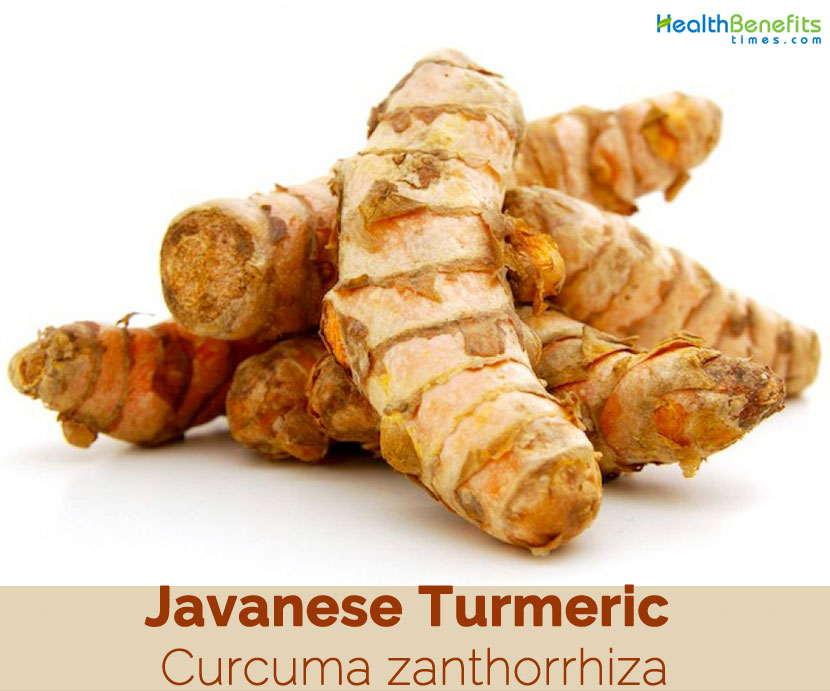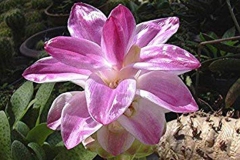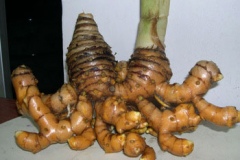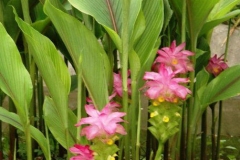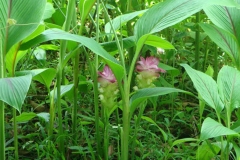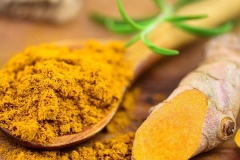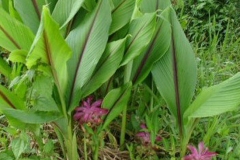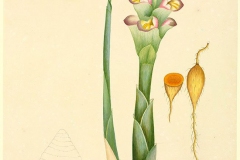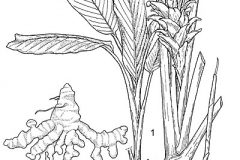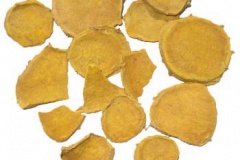Curcuma zanthorrhiza is used as a medicinal plant. It has been traditionally used to treat stomach diseases, liver disorders, constipation, bloody diarrhea, dysentery, children’s fevers, hemorrhoid, and skin eruptions. It has been used by Indonesian ancestors for food, medicinal purposes, and as a tonic. According to one source it is an effective preventive and pesticide of mushroom mites.
Plant description
Javanese Turmeric is an erect, robust, tillering and herbaceous perennial plant that grows about 1-2 m tall. The plant is found growing in thickets and teak forest. It prefers moist fertile, well-drained, humus-rich soil. Roots are numerous, fleshy and terete, up to 30 cm long, at the apex usually shortly swollen into a globose or ellipsoid tuber up to 2.5- 5 cm. Rhizome is a fleshy complex with an erect ovoid structure (primary tuber) at the base of each aerial stem; ringed with the bases of old scale leaves and when matures bearing numerous lateral rhizomes which are again branched. Primary tuber is 5-12 cm long and 3-10 cm in diameter. Lateral rhizomes are much smaller, often without particular shape, clavate or cylindrical, 1.5-10 cm long and 1-2 cm thick, outside yellowish or orange-red-brown turning greyish when older, inside intense orange or orange-red, younger parts paler.
Leaves
Leaf shoots bear up to 8 leaves surrounded by blade less sheaths, Leaf sheaths form a pseudo-stem. Sheaths are up to 75 cm long and green. Petiole is 0-30 cm long, its apex passing gradually into the blade. Blade is elliptical-oblong or oblong-lanceolate, 25-100 cm long and 8-20 cm wide, dark green above with a more or less intensely reddish-brown central streak 1-2.5 cm wide, light green or sea-green below, glabrous, densely white-dotted.
Flowers
Inflorescence is lateral, sprouting from the rhizome next to the leaf shoot and are spike-like. Peduncle is 10-25 cm long, covered by rather large bladeless sheaths. Flower spike is cylindrical, 15-25 cm long, 10-20 cm in diameter and is provided with 15-35 bracts arranged spirally, each containing a flower except the 5-6 upper ones; bracts in their lower half adnate to each other, the basal parts thus forming closed pockets, the free upper parts more or less spreading. The 10-20 upper bracts are purplish and longer and narrower than the 10-20 light green lowest bracts. Bracteoles are small, membranous, surrounding the flowers.
Calyx is small, 1-1.5 cm long; corolla is 4-6 cm long, lower half tubular, upper half much widened, light red, 3-lobed with 2 equal anterior lobes and a larger ventricose posterior one. Labellum is sub orbicular, weakly 2-lobed, about 2 cm in diameter, yellowish with a darker yellow longitudinally furrowed central streak. Staminodes are large and wide, connate with the base of the stamen, yellow-white. Filament is short and wide, anther thick, at the base with claw-like spurs. Ovary is white, pubescent, 4-5 mm long.
Health Benefits of Javanese Turmeric
Listed below are some of the well-known health benefits of Javanese Turmeric
1. Overcoming indigestion
Various health disorders in the digestive tract such as flatulence, dyspepsia, and indigestion can be overcome with Javanese Turmeric. Research states that patients who experienced health problems found in the ulcerative colitis disease is getting better by taking Javanese Turmeric supplements on a regular basis.
2. Increase your appetite
For parents who have children with low appetite, Javanese Turmeric can be a powerful drug to increase your child’s appetite. Certainly in a form that has been processed so it can be very safe and delicious when consumed by your child. Javanese Turmeric can quicken the process of emptying the stomach so that the appetite will soon increase again.
3. Treats Cancer
Javanese Turmeric can control, prevent, or even kill various types of cancer including colon, breast, and prostate. Research also showed that Curcuma considerably prevents the growth and spread of prostate cancer. The herb is supposed to work by inhibiting the growth of blood vessels that aids cancerous growth. Its preventive effects are assumed to be supported by its antioxidant activity, which protects your cells from damage.
4. Increase endurance
All parts of Javanese Turmeric are effective but the rhizomes are most widely used. Rhizome consists of more than one hundred kinds of compounds such as amylase, phenolase, fat, starch, minerals, phenol derivatives (curcuminoids) and essential oils. These compounds proved to be effective in optimally improving endurance.
5. Prevent and cure acne
Javanese Turmeric has an astringent attribute that causes the reduction in the pores of the skin so that it indirectly will prevent the appearance of acne on the skin surface.
6. Alternative medicine for liver dysfunction
Kurkuminoid has the efficacy of treating disorders of liver health and prevent fatty liver cells. Several scientific studies and clinical trials have been carried out by scientists from both Indonesia and the world, and the result generally supports the use of Javanese Turmeric as a traditional medicine that can use to liver disease and stiff.
7. Normalize the affected tissue
In the world of physiotherapy, Javanese Turmeric is classified as an adaptogen, a harmless substance that can encourage increased resistance to toxins or which can affect physically, chemically and biologically. In general, it has the effect of normalizing the affected tissue.
8. Ease osteoarthritis
Osteoarthritis is one of the most common causes of disability in the US. Research indicated that taking Javanese Turmeric for 4 weeks could help relieve pain associated with osteoarthritis among the people who already have the condition.
9. Prevent tumors
Javanese Turmeric also has the benefit of preventing the action of enzymes or other components that cause the growth of tumor cells. So the regular use of Javanese Turmeric in tumor sufferers is the right step.
10. Prevent the appearance of dengue fever
Essential oil content of Javanese Turmeric has the use of inhibiting Aedes aegypti mosquitoes to get closer to your body. This will cause you to avoid the danger of dengue fever because this type of mosquito is a carrier of dengue virus.
Ayurvedic benefits of Javanese Turmeric
1. Hepatitis Cure
Prepare the 2 Javanese Turmeric, then wash and Peel. Sliced and boiled with ½ liter water and add a little Palm sugar. Boil until the water becomes half. Drink this concoction twice a day.
2. Relieve suffering asthma
Prepare ½ Rhizome of Javanese Turmeric, and then wash clean. Peel and slice Javanese Turmeric. Boil 5 cups of water and combine Palm sugar to taste. Boil until the water becomes half. Take this herbal drink three times a day.
3. Treatment for kidney pain
Javanese Turmeric washed clean and peeled. Prepare 4 glasses of water and then with a handful of Javanese Turmeric cook Java tea leaves and a handful of meniran leaves. Boil until the water is left half. This stew is taken three times a day.
4. Cure boils
Clean Javanese Turmeric and then peeled. Boil 2 cups of water with Javanese Turmeric and little Palm sugar. Cook up to half the water and lift. Add one spoke. Wait for it cool slightly, then strained and drunk all at once.
5. Reduce muscular fatigue
Javanese Turmeric is also effective to help cope with muscular fatigue, especially for those of you who do exercise serious time fitness.
Traditional uses and benefits of Javanese Turmeric
- Rhizomes are used in Indonesian folk medicine as cholagogues, aromatic stomachic, analgesics, and a rheumatic remedy.
- Rhizomes of Java turmeric have been traditionally used for medicinal purposes in Malaysia, Singapore and Indonesia.
- It is administered for indigestion and rheumatism, as a tonic after childbirth and as an emmenogogue in amenorrhea.
- Rhizome is used in Indonesian traditional medicine for various therapeutic purposes such as anti-hypertensive, anti-rheumatic, antioxidant, anti-inflammatory, etc.
- Rhizomes are used as a tonic in many jamus in Indonesia.
- It is the most popular Indonesian herbal for hepatitis remedy and other liver disorders.
- It is considered a broad spectrum hepato protective agent useful in the treatment of liver injuries and can protect the liver from various hepato-toxins, encourage bile discharge and prevent the formation of gallstones and stomachic to treat various abdominal complaints and normalize digestion.
- Decoction of the rhizome is used for fever and constipation and taken by women as a galactagogue and to reduce uterine inflammation after childbirth.
- Recently, it has been used in supplement beverages to increase appetite and to refresh stamina.
- It was also reported to prevent avian flu.
- It is used for the topical treatment of acne and skin inflammations in Thailand.
- Rhizome is used to relive stomach ache in Thailand.
- Rhizome is used in dyspeptic complaints and as stomachic and carminative.
- Turmeric, java turmeric and cassumunar ginger are widely used in traditional Indonesian medicines.
- It heals Inflammation and boosts longevity.
- Root or rhizome of the herb is widely used for medicinal purpose.
- It is very effective in treating a number of diseases.
- It is good for the health of Heart and Liver.
- It is a very effective remedy for Arthritis, Gastrointestinal problems and Kidney disorders.
- It reduces the Blood fat and lowers the Cholesterol level in the Body.
- It inhibits the growth of Prostate Cancer.
- It increases flow of milk during Breast feeding.
- It fights Premature Aging.
- It treats Constipation.
Culinary Uses
- Young rhizome tips, inflorescence and centers of spurious stem are aromatic with a strong odor and bitter taste and are eaten as vegetables raw or cooked.
- Heart of the spurious stems is eaten raw or cooked as lalab.
- Young tops of the lateral rhizomes are also eaten fresh as lalab, and the inflorescences are eaten cooked with rice, usually as ‘sayur’ or ‘urab’.
- In Java a soft drink called ‘bir temu lawak’ or ‘wedang temu lawak’ is prepared by cooking dried pieces of the rhizomes which impart a yellow color and flavor and mixing with Javanese sugar.
- Rhizomes yield starch meal which is used in making porridge; pudding; delicacies like ‘dodol temu lawak’, ‘jenang temu’ and ‘jenang pati’; and drinks in Java.
- Rhizome is an important ingredient in various ‘jamu’.
- Starch obtained from the roots is used for porridge and as a pudding.
- Flowers are cooked and eaten with rice.
Dosing considerations for Javanese Turmeric
Appropriate dose of Javanese turmeric depends on several factors such as the user’s age, health, and several other conditions. At this time there is not enough scientific information to determine an appropriate range of doses for Javanese turmeric. Keep in mind that natural products are not always necessarily safe and dosages can be important. Be sure to follow relevant directions on product labels and consult your pharmacist or physician or other healthcare professional before using.
Precautions
- Avoid use during pregnancy and breast feeding.
- Avoid use if you have liver disease and gallbladder problems.
- The plant may not be safe when used in large quantities or for a long period of time.
- Larger dose may cause gastric irritation and nausea.
References:
https://en.wikipedia.org/wiki/Curcuma_zanthorrhiza
http://tropical.theferns.info/viewtropical.php?id=Curcuma+zanthorrhiza
https://uses.plantnet-project.org/en/Curcuma_xanthorrhiza_(PROSEA)
https://indiabiodiversity.org/species/show/264128
https://npgsweb.ars-grin.gov/gringlobal/taxonomydetail.aspx?411356
https://iopscience.iop.org/article/10.1088/1742-6596/1108/1/012099/pdf
Comments
| Javanese Turmeric Quick Facts | |
|---|---|
| Name: | Javanese Turmeric |
| Scientific Name: | Curcuma zanthorrhiza |
| Origin | Indonesia—Java, Bali and Moluccas. It is cultivated in Java, Malaysia, Thailand, Vietnam, the Philippines, Yunnan in China and also in India and Surinam. |
| Colors | Light yellowish brown (Rhizome) |
| Shapes | Subterranean, irregularly branched, thickened and fleshy (Rhizome) |
| Flesh colors | Deep orange color (Rhizome) |
| Taste | Bitter |
| Health benefits | Treats Cancer, Prevent dengue fever, Increase your appetite, Prevent and cure acne, Overcoming indigestion, Prevent tumors, Increase endurance, Ease osteoarthritis, Normalize the affected tissue, Alternative medicine for liver dysfunction |
| Name | Javanese Turmeric |
|---|---|
| Scientific Name | Curcuma zanthorrhiza |
| Native | Indonesia—Java, Bali and Moluccas. It is cultivated in Java, Malaysia, Thailand, Vietnam, the Philippines, Yunnan in China and also in India and Surinam |
| Common Names | False Turmeric, Giant Curcuma, Indian Saffron, Java Turmeric, Javan Turmeric, Javanese Turmeric, Curcumine, gedè, haridra, indian saffron, jiang huang, shu gu jiang huang, temu lawak, tumulawak |
| Name in Other Languages | Chinese : Shu Gu Jiang Huang, Yin Ni E Zhu Danish : Gurkemeje Dutch: Temu Lawak English : Giant curcuma, False turmeric French : Curcuma German : Javanische Gelbwurz, Javanische, Temoe lawak Gelbwurzel, Kurkuma Hungarian : Jávai Kurkuma Indonesia : Temu Raya, Temu Lawak, Koneng Gede, Temo Labak, koneng gede Malay: Temu lawas, Temu lawak Malayalam: Manjakoova, Pulakizhangu, Adavikachola, Kasthurimanjal Malaysia : Temu Lawas, Temu Raya Polish : Kurkuma Jawajska Spanish : Temoe-Lawak Thailand : Wan-Chak-Mod-Luk (ว่านชักมดลูก) Turkish : Zerdecali Vietnam : Nghệ vàng, nghệ rễ vàng |
| Plant Growth Habit | Erect, robust, tillering and herbaceous perennial |
| Growing Climates | Found in thickets and teak forest |
| Soil | Moist fertile, well-drained, humus-rich soil |
| Plant Size | 1–2 m tall |
| Root | Roots are short with large tubers; shape of root stock oblong, short, color reddish-yellow |
| Rhizome | Rhizome is large and with a deep orange color inside. The primary rhizome may reach 12cm long and 10cm in diameter. The lateral rhizomes are much smaller cylindrical and reaches up to 10cm long and 3cm diameter |
| Stem | Robust and erect, at the base enclosed by 2–3 sheaths and higher up with 2–7 distichous leaves |
| Leaf | Leaf shoots bear up to 8 leaves. The leaf sheath is green, forms a pseudostem and can reach up to 75cm long. The petiole is 30cm long. The leaf blade is elliptical-oblong or oblong-lanceolate measuring between 25-100cm x 8-20cm, dark green above with a distinct reddish-brown central streak measingn 1-2.5cm wide. |
| Inflorescences | Separate shoots arise from rhizomes; spike is 16–25 × 8–10 cm; fertile bracts are pale green; coma bracts are purple, and apical ones are much narrower; each flower is surrounded by a membranous pink bracteoles which are 2.5 cm long |
| Flower | Separate shoots arise from rhizomes; spike is 16–25 × 8–10 cm; fertile bracts are pale green; coma bracts are purple, and apical ones are much narrower; each flower is surrounded by a membranous pink bracteoles which are 2.5 cm long |
| Propagation | By division of the rhizomes |
| Flavor/Aroma | Aromatic, pungent odor |
| Taste | Bitter |
| Plant Parts Used | Root, rhizome |
| Health benefits |
|
| Other Facts |
|


